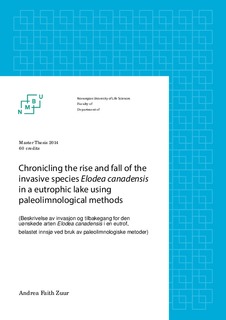| dc.contributor.author | Zuur, Andrea | |
| dc.date.accessioned | 2015-05-08T10:52:11Z | |
| dc.date.available | 2015-05-08T10:52:11Z | |
| dc.date.copyright | 2014 | |
| dc.date.issued | 2015-05-08 | |
| dc.identifier.uri | http://hdl.handle.net/11250/283367 | |
| dc.description | An investigation of the introduction and die-out of Elodea canadensis in the eutrophic lake Årungen. Sediment cores were analyzed for metals and absorbance and numerically analyzed for individual pigments. Streams were sampled during low and high flows and analyzed for metals. E. canadensis died out as a result of high Levels of metals in urban road runoff delivered in high concentrations during peak flows. | nb_NO |
| dc.description.abstract | The history of the introduction and disappearance of the invasive aquatic plant Elodea canadensis (E. canadensis) in lake Årungen, a eutrophic, disturbed lake, was studied using paleolimnological techniques to investigate how the species was introduced, and why it disappeared. A variety of field, lab and numerical methods were used to pursue this investigation.
The paleolimnological methods included the removal of two sediment cores from the lake and spectroscopically analyzed for absorbance and for concentrations of the metals cadmium, copper, zinc, chromium, lead and manganese to determine if the disappearance was associated with the presence of metals. High levels of metals associated with road runoff from a nearby highway had been measured in another study, leading to the hypothesis that road runoff could have caused the demise of E. canadensis in lake Årungen. The sediment cores were also analyzed for percent water, dry matter and organic matter. A numerical analysis was conducted on the absorbance data obtained from the spectroscopic analysis to separate individual pigment data from the absorbance data, using methods developed by Prof. Hendrik Küpper (Küpper et al., 2007)
Field surveys were conducted in lake Årungen and in the streams contributing to the location where the sediment cores were removed. Streams and overflow pipes were sampled during low flows and high flows including locations receiving discharge from road and urban runoff and combined sewer and stormwater discharge. Stream and sediment samples and samples of E. canadensis were analyzed for cadmium, copper and zinc. Historical documents were also searched for information about changes in the landscape that could have contributed to the introduction and disappearance of E. canadensis.
The search of historical records show that E. canadensis was very likely introduced during the construction of a rowing pier in the lake. The pier construction occurred during the same time period in which a new highway was constructed, resulting in a change in traffic patterns that greatly reduced traffic on a road adjacent to the lake, and reduced the amount of metals being introduced into the lake. An investigation of the installation of municipal and highway stormwater drainage systems revealed that runoff from several drainage systems was entering the lake at one location. Over time, the levels of metals in the lake increased concurrently with increasing traffic on the highway, which is attributable to levels of metals measured in road and urban runoff discharging into this location.
The continuous inputs of metals and perhaps other pollutants from urban and road runoff very likely caused an initial decline of E. canadensis. Multiple sources of pollutants discharging at high concentrations during extreme rainfall and rain-on-snow events in 2006 and 2007 probably caused the final die-off of the plant. If this is the case, this has larger ecological implications for both lake Årungen and other lakes receiving multiple inputs of urban and road runoff in the form of peak flows. | nb_NO |
| dc.language.iso | eng | nb_NO |
| dc.publisher | Norwegian University of Life Sciences, Ås | |
| dc.rights | Navngivelse-Ikkekommersiell-IngenBearbeidelse 3.0 Norge | * |
| dc.rights.uri | http://creativecommons.org/licenses/by-nc-nd/3.0/no/ | * |
| dc.subject | limnology | nb_NO |
| dc.subject | paleolimnology | nb_NO |
| dc.subject | watershed science | nb_NO |
| dc.subject | sedimentology | nb_NO |
| dc.subject | spectroscopy | nb_NO |
| dc.subject | Årungen | nb_NO |
| dc.subject | peak flows | nb_NO |
| dc.title | Chronicling the rise and fall of the invasive species Elodea canadensis in a eutrophic lake using paleolimnological methods | nb_NO |
| dc.title.alternative | Beskrivelse av invasjon og tilbakegang for den uønskede arten Elodea canadensis i en eutrof, belastet innsjø ved bruk av paleolimnologiske methoder | nb_NO |
| dc.type | Master thesis | nb_NO |
| dc.subject.nsi | VDP::Mathematics and natural science: 400::Zoology and botany: 480::Limnology: 498 | nb_NO |
| dc.source.pagenumber | 84 | nb_NO |
| dc.description.localcode | M-PV | nb_NO |

